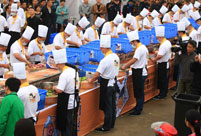A photo exhibition opened in Beijing on April 15 to mark the 95th anniversary of the "May Fourth Movement," an important cultural and political movement in modern China.
Hosted by the New Culture Movement Memorial of Beijing and Duke University Libraries (DUL), the exhibition displays 143 photographs showing China's "May Fourth Movement" and people's lives at that time.
They were taken by American photographer Sidney D. Gamble (1890-1968), grandson of James Gamble, one of the co-founders of Proctor & Gamble (P&G).
"In early 1900s, photos were rarely seen in China, and few survive today. Gamble captured valuable historical moments from the perspective of a sociologist and preserved those images well," said Guo Junying, curator of the memorial.
The photographs include students delivering speeches, being arrested and protesting during the "May Fourth Movement" in 1919.
"They open a window for Chinese to better understand their history and complement existing historical document for that period," she said.
The "May Fourth Movement" started with mass student protests on May 4, 1919 against the government's response to the Treaty of Versailles that imposed unfair penalties on China and undermined the country's sovereignty. It then began a national campaign to overthrow the feudal society and promote scientific and democratic ideas.
Gamble worked as secretary for the Beijing Young Men's Christian Association (YMCA), witnessing and documenting this pivotal event. In 1908, he began taking pictures in China during the first trip here with his family. He returned three more times between 1917 and 1932 and traveled widely, collecting data for socio-economic surveys and photographing urban and rural life, public events, architecture, religious statuary and countryside.
About 15 years after Gamble's death, his daughter found his nitrate negatives in a closet at home in New York. Stored in beautiful rosewood boxes, the negatives were housed in individual paper sleeves, annotated with typed and handwritten captions. An agreement to bring the collection to Duke was signed in 2006.
"I was immediately fascinated by these images of Chinese life more than 100 years ago as I tried to figure out the location and background of each picture, and later as I translated their titles into Chinese. Since then, I have wanted to promote this collection to audiences around the world," said Zhou Luo, a researcher with Duke University.
Zhou started working on the metadata on the Gamble photographs in 2008, when the images had been sent to DUL after digitization.
Among the 5,000 photographs in this collection are about 2,000 images related to Beijing. "The majority of images were never published or exhibited during his lifetime," Guo Junying said.
The memorial has received about 300 to 400 visitors on work days and nearly 700 on weekends since the exhibition opened. The exhibition has presented an exciting opportunity for young Chinese to better understand the "May Fourth Movement" and given a panoramic picture of society.
"In a picture that shows traditional Chinese funeral, I saw a paper car. It's amazing. I never expected that these luxury sacrifices had such long history in China," said a visitor from Beijing.
A middle school student said that young Chinese lack such passion today and they need to learn from spirits of this movement.
"The spirits involve patriotism, progress, democracy and science. While we make more money and enjoy a better life today, we need to seek spiritual pursuit and faith. This exhibition gives us a new perspective to know our history in a vivid and objective way," Guo Junying said.
 The Western Qing Mausoleum
The Western Qing Mausoleum Overseas returnees strive for dreams in Beijing
Overseas returnees strive for dreams in Beijing Fried up: Chili pork bonanza in Central China
Fried up: Chili pork bonanza in Central China Hand-painted maps go viral online
Hand-painted maps go viral online 4th Beijing Int'l Film Festival ends
4th Beijing Int'l Film Festival ends Commando elite specializes in sign language
Commando elite specializes in sign language Man photoshops himself into girlfriend's childhood photos
Man photoshops himself into girlfriend's childhood photos Photo story: Stallholders at Beijing Zoo Wholesale Market
Photo story: Stallholders at Beijing Zoo Wholesale Market Artists on backstage
Artists on backstage 'African Street' in Guangzhou
'African Street' in Guangzhou Special operation members in comprehensive training
Special operation members in comprehensive training Cute Shaolin boy melts the hearts of millions
Cute Shaolin boy melts the hearts of millions Giant panda Sijia is back to happy life
Giant panda Sijia is back to happy life Richest Chinese of 2014: half from the mainland
Richest Chinese of 2014: half from the mainland Chengdu - laid-back lifestyle makes happiest city
Chengdu - laid-back lifestyle makes happiest cityDay|Week|Month